The 1940s — An overview of special effects
At the beginning of the 40s, most of Hollywood’s leading effects people had over a decade of experience in studio production behind them and were masters of the various techniques available to them. Rear projection, optical printing, matte painting, etc, played a key role in the majority of studio productions, and were considered as a part of the normal film production process.
The rise of color photography as a viable option production in the 1940s, brought significant changes to the industry. For effects technicians, color was a challenge. Rear projection in color was at first a vivid but unattainable dream. The background images projected on to a screen behind actors in the studio were not bright enough to be re-filmed in color. Nonetheless a powerful new projection system devised at Paramount helped to overcome this problem in the early 1940s.
Travelling matte techniques (techniques which convincingly combine images that have been filmed at different times or locations) also needed modification to accommodate colour. The first new method was pioneered and used in the 1940 version of The Thief of Bagdad.
 The Caliph enjoys an airborne horse ride over his city in one of the first-ever Technicolor blue-screen travelling mattes for The Thief of Bagdad. The film won the Academy Award for Best Special Effects in 1940.
The Caliph enjoys an airborne horse ride over his city in one of the first-ever Technicolor blue-screen travelling mattes for The Thief of Bagdad. The film won the Academy Award for Best Special Effects in 1940.
 Blue-screen separation process, employed for the first time in The Thief of Bagdad (1940).
Blue-screen separation process, employed for the first time in The Thief of Bagdad (1940).
The technique that was most affected by the arrival of color was matte painting. In black-and-white the painter and the photographer only had to worry about matching the greyscale tones of painting and filmed action. In Technicolor, however every color and shade of painting had to match exactly those of the original footage after both had been combined under different lighting conditions. The first major display of Technicolor matte painting was Gone with the Wind (1939).
 A screenshot from the epic Gone with the Wind, a successful blend of painting and live action.
A screenshot from the epic Gone with the Wind, a successful blend of painting and live action.
Despite the success of Technicolor, however, it was both an intensive and expensive system, and so was generally reserved for prestige productions. Thus the majority of films in the 1940s continued to be shot in black-and-white.
After the United States entered the war in 1941, Hollywood began to mass-produce war films. Many of the American war films in the early 1940s were designed to celebrate American unity and demonize the enemy. Thus the re-creation of battlefields, destroyer-prowled oceans and fighter-filled skies fell to the effects technicians ; and so war films relied heavily on models and miniature photography.
 Films such as Ships with Wings (1942) relied on model ships, planes and miniature pyrotechnics for their portrayal of war.
Films such as Ships with Wings (1942) relied on model ships, planes and miniature pyrotechnics for their portrayal of war.

 The rally scene — virtually all paint except for the stage area.
The rally scene — virtually all paint except for the stage area.
 A FX technique consisting in combining a matte painting for the background with a miniature mountainside with dozens of stop motion trucks and machinery. This unfinished frame still lacks the foreground component which will be added during process projection.
A FX technique consisting in combining a matte painting for the background with a miniature mountainside with dozens of stop motion trucks and machinery. This unfinished frame still lacks the foreground component which will be added during process projection. Linwood Dunn with an optical printer
Linwood Dunn with an optical printer Principle of composition technique with a four-head optical printer
Principle of composition technique with a four-head optical printer For The Invisible Man (1933), the FX team used mechanical systems and wires to make doors open, chairs move and items float around as if the unseen hero of the film was actually interacting with them. In the above scene, the presence of the invisible man indicated by the appearance of his footprints in fresh snow is achieved thanks to a floor with foot-shaped holes in it which are opened sequentially during the filming causing the effect of snow compressed by invisible feet.
For The Invisible Man (1933), the FX team used mechanical systems and wires to make doors open, chairs move and items float around as if the unseen hero of the film was actually interacting with them. In the above scene, the presence of the invisible man indicated by the appearance of his footprints in fresh snow is achieved thanks to a floor with foot-shaped holes in it which are opened sequentially during the filming causing the effect of snow compressed by invisible feet. Technicians stage an indoor sea battle for Jack Ahoy (1934).
Technicians stage an indoor sea battle for Jack Ahoy (1934).
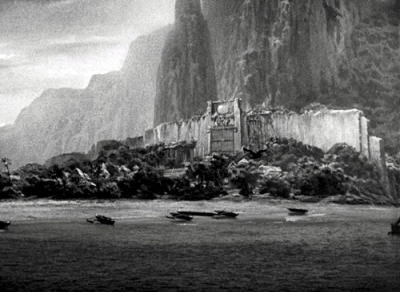
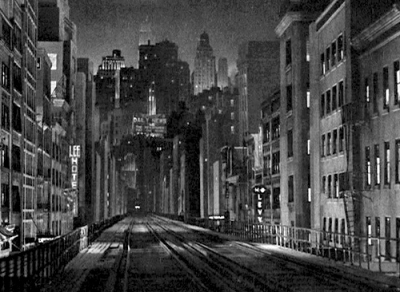 Matte paintings were used to portray many locations including the established shots of Skull Island and the New York skyline.
Matte paintings were used to portray many locations including the established shots of Skull Island and the New York skyline.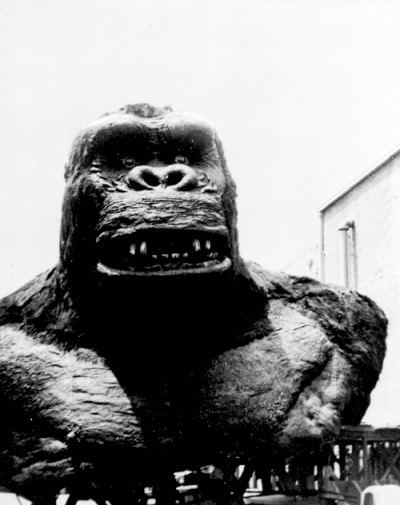
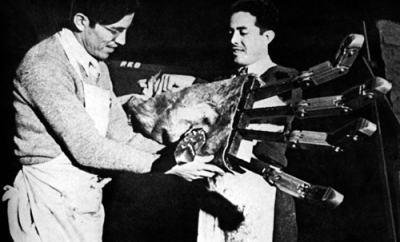 The mighty Kong was portrayed by a 46 cm puppet made of an assemblage of metal, rubber and fur. For Kong, Delgado even stretched rubber tendons between joints to give the ape a realistic sinewy appearance. A full-size bust, arm and leg were built for close-ups. Stop-motion was used for animating the Kong puppet, just as the Skull Island dinosaurs, and the attacking aircraft sequences.
The mighty Kong was portrayed by a 46 cm puppet made of an assemblage of metal, rubber and fur. For Kong, Delgado even stretched rubber tendons between joints to give the ape a realistic sinewy appearance. A full-size bust, arm and leg were built for close-ups. Stop-motion was used for animating the Kong puppet, just as the Skull Island dinosaurs, and the attacking aircraft sequences.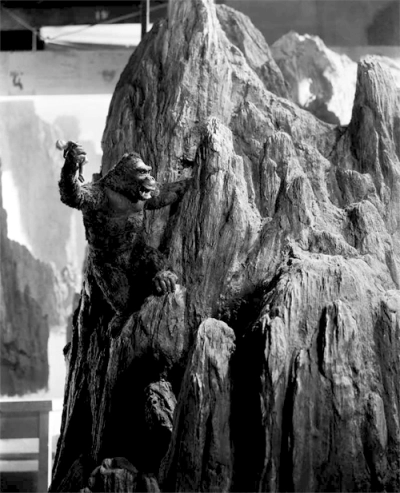 A nice behind the scenes photo revealing the detail of the model miniatures and the size of the matte painting backings.
A nice behind the scenes photo revealing the detail of the model miniatures and the size of the matte painting backings.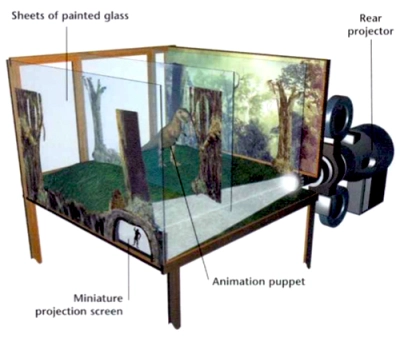 Miniature rear projection process.
Miniature rear projection process.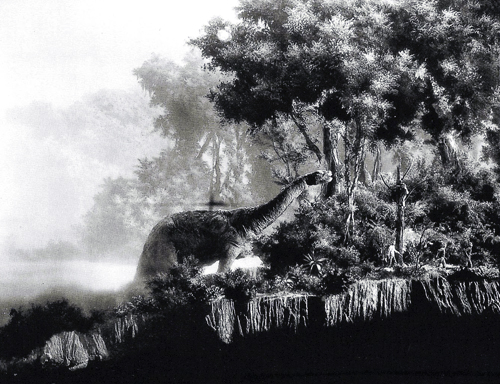 A model dinosaur through O’Brien’s atmospheric forest settings. The bottom of the image has been matted out to receive a live-action element.
A model dinosaur through O’Brien’s atmospheric forest settings. The bottom of the image has been matted out to receive a live-action element. Screenshot of The Lost World (1925), this ambitious American version of Conan Doyle’s novel used startling stop-motion animated dinosaurs miniatures created by Willis O’Brien (who will manage the special effects in the 1933 version of King Kong).
Screenshot of The Lost World (1925), this ambitious American version of Conan Doyle’s novel used startling stop-motion animated dinosaurs miniatures created by Willis O’Brien (who will manage the special effects in the 1933 version of King Kong). Fritz Lang’s effects masterpiece, Metropolis (1926), a visionary science-fiction fable that made stunning use of more than 200 matte paintings and models.
Fritz Lang’s effects masterpiece, Metropolis (1926), a visionary science-fiction fable that made stunning use of more than 200 matte paintings and models. Douglas Fairbanks on a flying carpet suspented by unseen wires above hundreds of extras on the set of The Thief of Bagdad (1924).
Douglas Fairbanks on a flying carpet suspented by unseen wires above hundreds of extras on the set of The Thief of Bagdad (1924). From off-camera, the miniature components of the arena used for Ben Hur (1925) is clearly visible. When filmed from the correct angle, the combination of full-scale set and miniature is seamless (bottom). The foreground miniature film technique used is succinctly explained by the sketch below.
From off-camera, the miniature components of the arena used for Ben Hur (1925) is clearly visible. When filmed from the correct angle, the combination of full-scale set and miniature is seamless (bottom). The foreground miniature film technique used is succinctly explained by the sketch below. The foreground miniature is exactly what its name suggests : a small model that is carefulled designed and placed in front of the full-scale film set (so their line of perspective match seamlessly together). This technique (therefore often called “hanging miniatures“) will be frequently used in the 1930s and 40s film productions.
The foreground miniature is exactly what its name suggests : a small model that is carefulled designed and placed in front of the full-scale film set (so their line of perspective match seamlessly together). This technique (therefore often called “hanging miniatures“) will be frequently used in the 1930s and 40s film productions.